An extended Kalman filter extension of the augmented Markov decision process
Author(s)
Lommel, Peter Hans
DownloadFull printable version (8.242Mb)
Other Contributors
Massachusetts Institute of Technology. Dept. of Aeronautics and Astronautics.
Advisor
Nicholas Roy and Marc W. McConley.
Terms of use
Metadata
Show full item recordAbstract
As the field of robotics continues to mature, individual robots are increasingly capable of performing multiple complex tasks. As a result, the ability for robots to move autonomously through their environments is a fundamental necessity. If perfect knowledge of the robot's position is available, the robot motion planning problem can be solved efficiently using any of a number of existing algorithms. Frequently though, the robot's position can only be estimated using incomplete and imperfect information from its sensors and an approximate model of its dynamics. Algorithms which assume perfect knowledge of the robot's position can still be applied by treating the mean or maximum likelihood estimate of the robot's position as certain. However, unless the uncertainty in the agent's position is very small, this approach is not reliable. In order to perform optimally in this situation, planners, such as the partially observable Markov decision process, plan over the entire set of beliefs (distributions over the robot's position). Unfortunately, this approach is only tractable for problems with very few states. Between these two extreme approaches, however, lies a continuum of possible planners which plan over a subset of the belief space. The difficulty that these planners face is choosing and representing a minimal subset of the belief space which spans the set of beliefs that the robot will actually experience. In this paper, we show that there exists a very natural such set, the set, of Gaussian beliefs. By combining an extended Kalman filter with an augmented Markov decision process, we create a path planner which efficiently plans over a discrete approximation of the set of Gaussian beliefs. (cont.) The resulting planner is demonstrated via simulation to be both computationally tractable and robust to uncertainty in the robot's position.
Description
Thesis (S.M.)--Massachusetts Institute of Technology, Dept. of Aeronautics and Astronautics, 2005. Includes bibliographical references (p. 99-102).
Date issued
2005Department
Massachusetts Institute of Technology. Department of Aeronautics and AstronauticsPublisher
Massachusetts Institute of Technology
Keywords
Aeronautics and Astronautics.